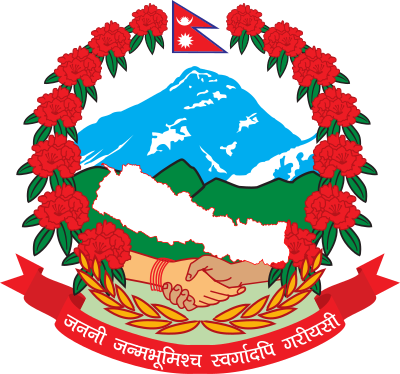
Search
Administrative divisions of Nepal

The administrative divisions of Nepal (Nepali: नेपालको प्रशासनिक विभाजन, romanized: Nēpālakō praśāsanik vibhājana) are subnational administrative units of Nepal. The first level of country subdivision of Nepal are the provinces. Each province is further subdivided into districts, each district into municipalities and rural municipalities, and each of those municipalities into wards. Before 2015, instead of provinces, Nepal was divided into developmental regions and administrative zones.
Fulfilling the requirement of the new constitution of Nepal in 2015, all old municipalities and villages (which were more than 3900 in number) were restructured into 753 new municipalities and rural municipalities. The former 75 district development committees (DDC) were also replaced by 77 new district coordination committees (DCC) which have much less power than the DDCs. At present there are 6 metropolitan cities, 11 sub-metropolitan cities, 276 municipalities, and 460 rural municipalities.
Provinces
Nepal is composed of seven provinces. They are defined by schedule 4 of the new constitution, by grouping together the existing districts. Two districts however are split in two parts, ending up in two different provinces.
Districts
Provinces are further divided into districts, of which there are 77, since 2015. Each of the districts is governed by a District Coordination Committee.
Municipalities of Nepal
Urban municipalities
Municipalities are places having at least some minimum criteria of population and infrastructure and declared as a municipality by the government. There are 293 municipalities in Nepal.
Urban municipalities are categorized into 3 levels:
- Metropolitan city (Mahanagarpalika)
- Sub metropolitan city (Upmahanagarpalika)
- Municipality (Nagarpalikas)
Rural municipalities
Rural municipalities (Gaunpalikas) were established in 2017, replacing the village development committees (VDCs). The main purpose of a gaunpalika resembles that of a VDC, but it has more rights on collection of royalty and taxes and has a higher annual budget than the VDC. Several VDCs were usually combined into each new gaupalika. There are 460 gaunpalikas in Nepal.
See also
- Local self-government in Nepal
- List of mayors of municipalities in Nepal
- List of chairpersons of rural municipalities in Nepal
Notes
References
Text submitted to CC-BY-SA license. Source: Administrative divisions of Nepal by Wikipedia (Historical)
Articles connexes
- Provinces of Nepal
- Administrative divisions of Uttar Pradesh
- List of Nepalese provinces by population
- List of districts of Nepal
- Rural municipality (Nepal)
- Former administrative units of Nepal
- List of Nepalese provinces by GDP
- List of gaunpalikas of Nepal
- Nepalis
- Outline of Nepal
- Municipalities of Nepal
- List of Nepalese provinces by Human Development Index
- List of cities in Nepal
- Village development committee (Nepal)
- List of administrative divisions by country
- Administrative divisions of Japan
- Administrative divisions of India
- Sagarmatha (disambiguation)
- Udayapur District
- Birendra of Nepal
Owlapps.net - since 2012 - Les chouettes applications du hibou




